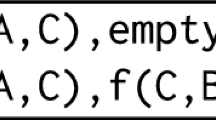Abstract
In this paper we describe TIM (Total Induction Method), a framework that empowers inductive learning in real domains by the construction of new higher level features based on the relations between the descriptors of the initial training set. A new method, named FDD, for discovering functional dependencies within the data is outlined, and details regarding its relevance for constructive learning are provided. Two examples of their application in real - world domains are given.
Preview
Unable to display preview. Download preview PDF.
Similar content being viewed by others
References
Quinlan,J.R. “Learning Efficient Classification Procedures and their Application to Chess End Games”. Machine Learning: an Artificial Intelligence ApproachVolumen/no: 1Pag. 463–482 1983
Michalski, R.S. “A Theory and Methodology of Inductive Learning”. Machine Learning: an Artificial Intelligence Approach. Volumen/no: 1. Pag. 83–134. 1983.
Peña, D. “Estadística: modelos y métodos”. Ed. Alianza Universidad. 1992
Lippmann, R.P. “An Introduction to Computing with Neural Networks”. IEEE ASSP Magazine. Volumen/no: Abril. Pag. 4–22.1987.
Quinlan, J.R. “C4.5: Programs for Machine Learning”. Ed. Morgan Kaufmann. 1993
Michalski, R.S. y Kodratoff, Y. “Research in Machine Learning: Recent Progress, Classification of Methods, and Future Directions”. Machine Learning: An Artificial Intelligence Approach. Volumen/no: 3Pag. 1–30.1990
Bloomfield, B.P. “Capturing expertise by rule induction”. Knowledge Engineering Review. Volumen/no: 1/4.1986
Montes, C. “Feature Construction in Decision Tree Induction”. Research & Actvities Collection. Center for the Study of Language and Information. Stanford University. May, 1995.
Press, W.H., Tenkolsky, S.A., Vetterling, W.T. y Flannery, B.P. “Numerical recipes in C: the art of scientific computing.”. Ed. Cambridge Press. 1992.
Myers, R.H. “Clasical and modern regresion with application”. Ed. Duxbury Press. 1986.
Draper, N.R. y Smith, H. “Applied regression analysis”. Ed. Wiley. 1981.
Montes, C. “MITO: Método de Inducción Total”. Tesis Doctoral. Facultad de Informática. Universidad Politécnica de Madrid. España. 1994.
Author information
Authors and Affiliations
Editor information
Rights and permissions
Copyright information
© 1998 Springer-Verlag Berlin Heidelberg
About this paper
Cite this paper
Caraça-Valente, J.P., Montes, C. (1998). Improving Inductive learning in real-world domains through the identification of dependencies: The TIM Framework. In: Pasqual del Pobil, A., Mira, J., Ali, M. (eds) Tasks and Methods in Applied Artificial Intelligence. IEA/AIE 1998. Lecture Notes in Computer Science, vol 1416. Springer, Berlin, Heidelberg. https://doi.org/10.1007/3-540-64574-8_431
Download citation
DOI: https://doi.org/10.1007/3-540-64574-8_431
Published:
Publisher Name: Springer, Berlin, Heidelberg
Print ISBN: 978-3-540-64574-0
Online ISBN: 978-3-540-69350-5
eBook Packages: Springer Book Archive




